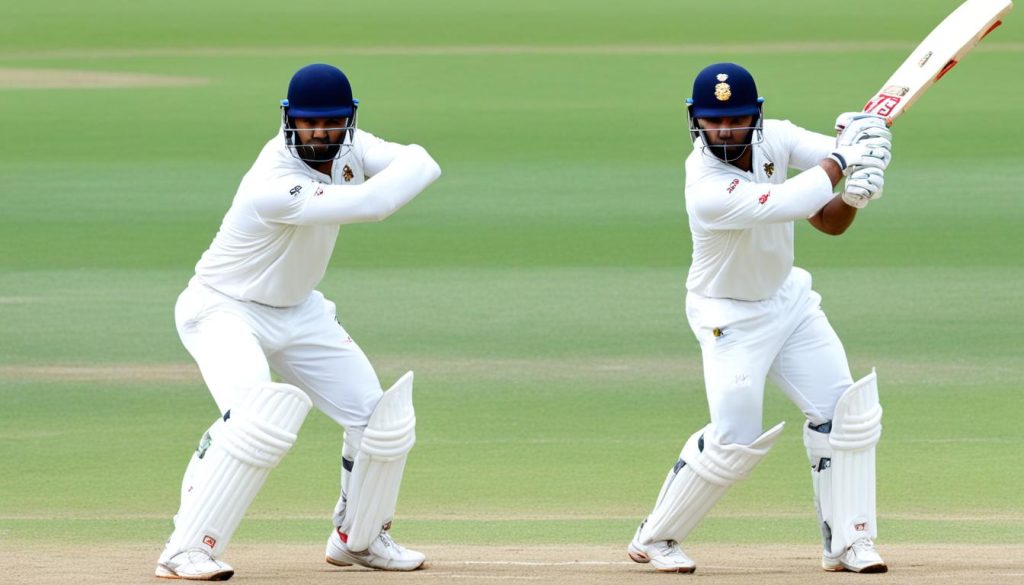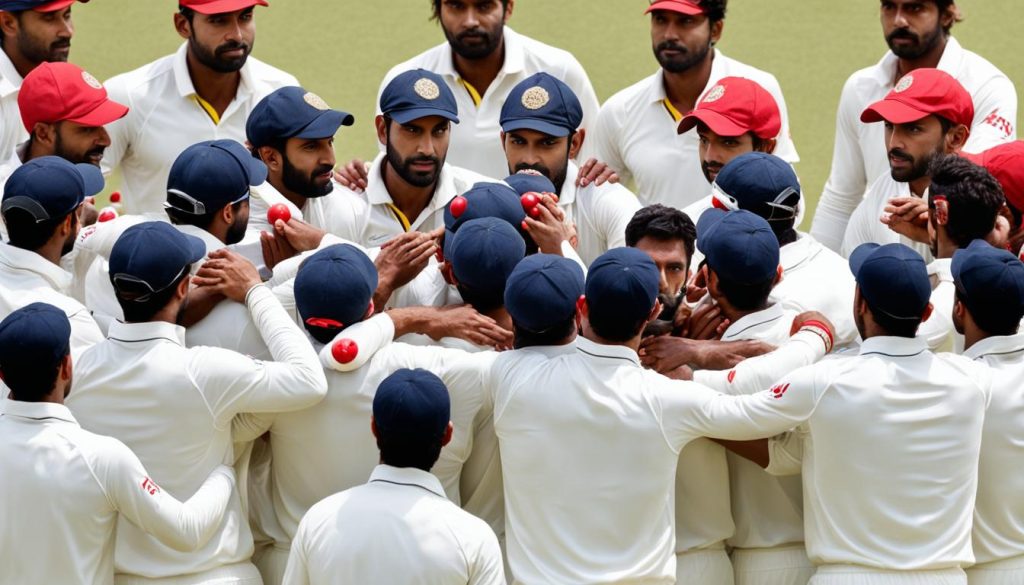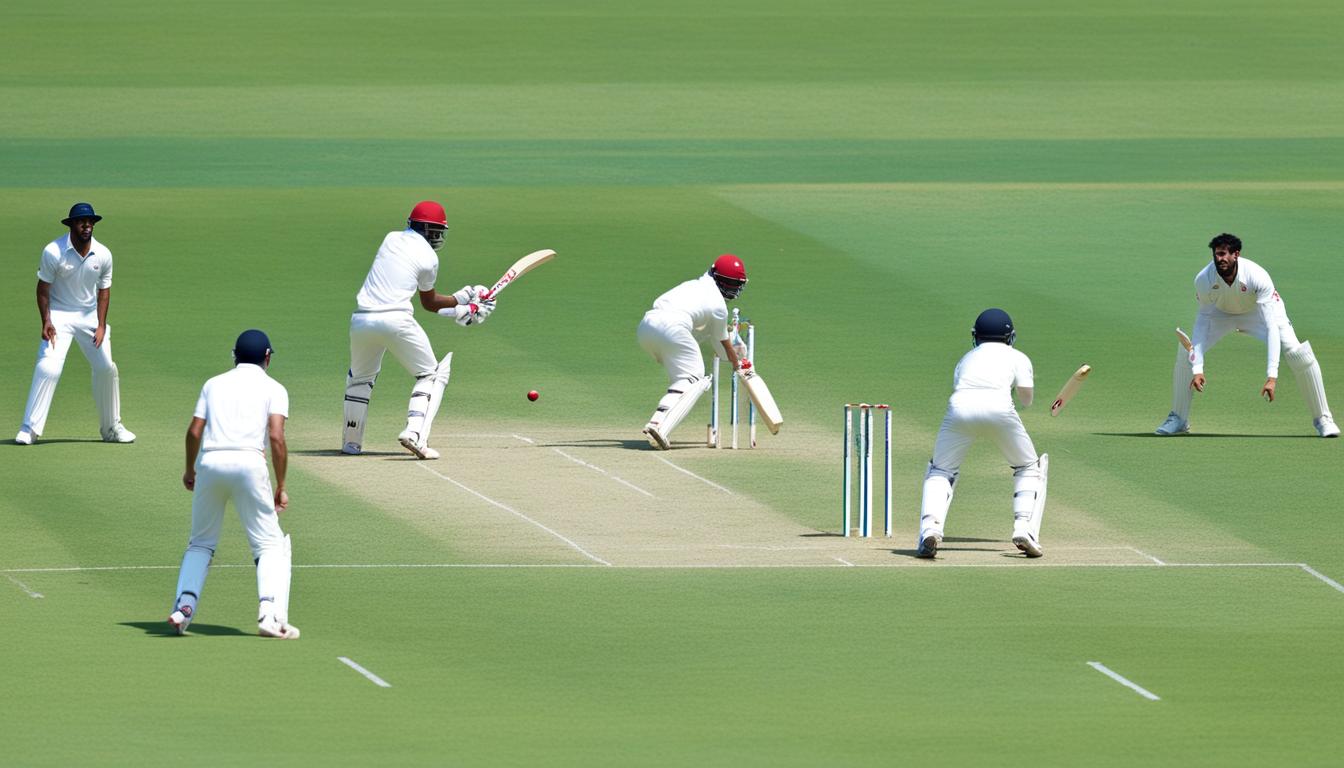As an aficionado of red ball cricket, I find myself perpetually enthralled by the intricate dance between enduring Test cricket tradition and the surge of modern cricket tactics. This timeless format, steeped in history, has been the stage for numerous cricket triumphs, and yet it stands resilient, continuing to evolve as it faces the rise of faster-paced formats. England’s recent success, coined ‘Bazball’ after the aggressive strategies implemented by Brendon McCullum and Ben Stokes, serves as a testament to the dynamic nature of red ball cricket. The synthesis of traditional reverence and avant-garde strategy exemplifies how the sport cherishes its past while boldly stepping into the future.
Key Takeaways
- The enduring allure of red ball cricket cherishes the rich fabric of Test cricket tradition.
- Modern cricket tactics, like those exhibited in ‘Bazball,’ are revitalizing the classic format
- Cricket triumphs often result from the harmonious blend of proven tradition and innovative strategy.
- Test cricket’s balance between aggression and thoughtfulness leads to exciting and unpredictable outcomes.
- Cultural shifts in cricket manifest as bold, new tactics, broadening the very horizons of the game.
- Persistent success in Test cricket calls for a meticulous marriage of historical wisdom and fresh approaches.
Breaking With Tradition: The Bazball Phenomenon
In the annals of cricket, a dramatic shift is occurring that is reshaping how the sport is played at the highest level of competition.
![]()
At the forefront of this evolution is the phenomenon known as Bazball, a term that encapsulates an approach to the game characterized by unabashedly aggressive batting. As a professional copywriting journalist and a keen observer of cricket, I’ve seen firsthand how this philosophy is not just a passing trend but a fundamental rethinking of batting doctrine.
Redefining Aggressive Batting
Aggressive batting isn’t new to cricket, but the way it’s being implemented today under the Bazball ethos is unlike anything seen before. The audacity with which batters confront bowlers, attacking virtually every ball, has rewritten the playbook of cricket strategy. Each stroke is valorous, each decision daring. Legends like Kevin Pietersen, Virender Sehwag, and Brian Lara paved the way, yet today’s practitioners have taken their cues to another level, blending courage with craft in a way that leaves spectators in awe and statisticians scribbling frantically.
The Impact of Pitch and Equipment Evolution
The stage for this batting revolution has been set not only by a mental shift but also by significant changes in cricket equipment and pitch evolution. The narrative of cricket pitches has transitioned from the realm of unpredictable demons to more curated canvases that offer consistency. Meanwhile, advancements in bats and protective gear afford batters greater confidence to take risks without fearing for their safety. This confluence of improved gear and pitch conditions has become fertile ground for the aggressive batting strategies that are, indubitably, enriching the sport.
Success Through Statistical Innovation in Strategy
Alongside technical evolution comes a statistical paradigm shift that is revolutionizing cricket tactics. Drawing inspiration from disciplines such as American football, where data-driven decisions have begun to challenge traditional play-calling, cricket too is entering an age where statistical strategy dictates choices once governed by gut and convention. This empirical onslaught courtesy of Bazball dares to flout long-established paradigms, favoring analytics that optimize every action on the field – a move from defensive gambits to offensive onslaughts with the backing of bespoke data analytics.
Now, we stand as witnesses to a game undergoing transformation, led by protagonists with bats in hand, who are not just changing how the game is played, but reimagining what it can become.
Red Ball Cricket: Preserving the Essence of the Sport
As I delve into the annals of Test cricket history, I am constantly reminded of its enduring appeal. While the game has welcomed innovative methods and strategies, the soul of cricket—traditional red ball cricket—remains untainted. There’s a reason why red ball cricket still commands respect; it’s a test not just of skill but of character, resilience, and an understanding of the sport’s rich legacy.
The Allure of Test Cricket’s Rich History
The history of red ball cricket is a tapestry woven with epic narratives and legendary confrontations. It’s a history where the patience and endurance tested over five days of play transcend the immediacy of life’s regular pace. Cricket lovers revere this longer format for its capacity to produce nuanced battles that are as much psychological as they are physical. The preservation of such traditions is what keeps the spirit of the Test format alive and thriving in an age of relentless change.
Traditions Triumphing Over Modern Tactics
A curious observation of mine in recent years has been the balancing act between adherence to tradition and the adoption of new techniques. England’s cricket, in particular, has manifested this duality—melding aggressive batting tactics seemingly borrowed from the white-ball format with the conventional Test match discipline focused on wickets over run restriction. This harmonious blend has introduced fresh excitement into traditional red ball cricket, without detracting from its quintessence.
Legendary Matches Defining Red Ball Cricket
There are certain matches in Test cricket history that are etched in the memories of fans forever. The legendary battles, such as the knife-edge suspense of the Ashes series or the 2005 series win that brought England to a standstill, are not merely games; they are narratives of human endeavor. These matches have offered something no other form of the game can—a true test of excellence, spread over days, where every session can tell a different story.
![]()
My appreciation for this classic form of the game is deepened when I recall such legendary cricket matches that have become folklore. It’s these moments that demonstrate that while formats like T20 may be the commercial powerhouses of cricket, the red ball game, with its storied history and unwavering respect for tradition, will always have its unique place at the heart of this beloved sport.
A Tactician’s Guide to Red Ball Success
As a seasoned observer of the sport, I’ve witnessed first-hand how modern cricket tactics have morphed, with a tactician’s approach at the helm steering teams toward red ball cricket success. It’s not merely about the flair and skill of individual players, but more about the collective strategic vision and planning. Take the “Bazball” phenomenon, for example, a strategy brimming with intentionality and a departure from the paralysis by analysis. It spotlights the significance of a lucid mind and strategic play, leading to decisive and robust action on the field.

At its core, a tactician’s guide embraces aggressive plays that facilitate straightforward, confident decision-making. The advocacy for this kind of play is not merely for the stronghold it affords a batter at the crease, but also for the doubts it plants in the minds of opposing fielders. Aggressive yet calculated stroke-play may seem high-risk, yet it is these very gambits that, when executed with skill, prove less likely to cost wickets.
Physical fitness and mental preparation are also pivotal aspects factored into this holistic approach. By delving deep into the opposition’s weaknesses, teams carve out tailored cricket tactics – an intellectual puzzle pieced together with thorough preparation and a commitment to relentless pursuit of excellence.
- Mood Analysis of Opponents
- Physical Conditioning
- Weather and Pitch Assessments
- Historical Success Rates
- Real-time Analytics
These elements constitute a playbook for modern cricketing strategies, transcending traditional thought processes and leading to widely acclaimed tactician’s approach in red ball cricket. It’s by wielding the double-edged sword of aggression and analytics that teams are rewriting the annals of cricket, stride by victorious stride.
When Aggression Meets Discipline: A Winning Mindset
The cricketing landscape is ever-evolving, with the rise of aggressive strategies being meticulously balanced with the time-honored virtue of cricket discipline. I’ve witnessed England’s “Bazball” redefine the paradigm of tactical aggression in Test cricket— encapsulating a winning mindset that elegantly blends thoughtful aggression with disciplined play. Simultaneously, the Indian cricket team’s recent performance at Lord’s spotlighted how mental resilience, underpinned by team unity, can culminate in some of the most memorable victories.

Aggression in Context: Lessons From Bazball
Studying England’s transformative approach offers unparalleled insights into how controlled aggression, when executed with precision and cricket discipline, can keep opponents on the back foot. England’s stride toward a winning mindset didn’t emerge out of sheer recklessness but through honed tactical aggression. It’s a boisterous call to arms, rooted deeply in strategic intent and respect for the game’s complexities.
India’s Tactical Aggression at Lord’s
Similarly, the Indian cricket team demonstrated that mindful aggression coupled with the right tactics can lead to astonishing results. Under Virat Kohli’s captaincy, the fast bowlers’ short-pitched deliveries weren’t merely for intimidation but perpetrated as a chess grandmaster would, move by strategic move—the crease their board, the ball their gambit. This brand of tactical aggression, steeped in diligent planning and cricket discipline, leads to triumphs that resonate far beyond the scoreboard.
Mental Resilience and Team Unity in Test Triumph
Mental resilience is the crucible within which the greatest of cricketing tales are forged. Whether it be England’s resurgence or India’s might at Lord’s, it was as much a mental conquest as it was a physical one. Team unity stands as the bedrock upon which mental fortitude is built; the shared vision and brotherhood that ultimately crafts a narrative of victory against the odds.
As chronicled in the annals of cricket, whether in the reverberating echoes of a stadium or amidst quiet reflections post-match, the integration of aggression and discipline has emerged as the cornerstone of a successful strategy. This interplay between the two dynamics fosters an environment in which the spirit of cricket is celebrated and the pursuit of triumph is relentless.
Conclusion
Throughout my exploration of the dynamic interplay between the steadfast traditions and bold modern strategies in red ball cricket, I’ve grown to appreciate that Test cricket is a complex tapestry, weaving together threads of disciplined aggression, tactical insight, and unwavering respect for its legacy. The advent of the Bazball strategy boldly challenges the fabric of the game’s conservative norms and has, intriguingly, led to team success that stirs up fervent discussion amongst purists and innovators alike. What becomes abundantly clear is that, while change may roll in with the vigor of a new era, the core essence of red ball cricket—its soul—is non-negotiable and remains treasured.
The refinement of a Bazball approach encourages a balanced alloy of cricket discipline and inventive play, a hybrid that has proven its worth on the pitch. This fusion exemplifies the evocative journey of red ball cricket—a voyage of preserving revered traditions while simultaneously navigating the shifting landscape of contemporary tactics. As these innovations continue to permeate the domain of Test cricket, they contribute to a vibrant and resilient narrative of an age-old sport refusing stagnation and embracing evolution.
Firmly grounded in the cultural bedrock of Test cricket, yet with a gaze fixed on the horizon, we witness a sport in a state of graceful transition. The meticulous craft of cricket discipline, honed through years of practice and dedication, now intersects with the audacious flair of the Bazball strategy. It’s a testament to the players and thinkers who dare to dream and execute—with precision, the possible new futures of red ball cricket. My deep dive into this realm reaffirms that at the heart of this beloved sport lies not just a game of bat and ball but an enduring legacy of tradition, tactics, and an unabated quest for triumph.
FAQ
What defines red ball cricket and how does it differ from other forms of cricket?
Red ball cricket refers to the longest format of the game, also known as Test cricket, which is played with a red ball as opposed to the white ball used in limited-overs games. It’s characterized by its emphasis on endurance, strategy, and tradition, encompassing multiple days of play and allowing for the full range of cricketing skills to be displayed.
What is “Bazball” and how has it changed England’s approach to red ball cricket?
“Bazball” is a term coined to describe the aggressive batting strategy implemented by the England cricket team under the leadership of Brendon McCullum (“Baz”) and Ben Stokes. It departs from traditional defensive tactics in favor of a more fearless and attacking style, aiming to score runs quickly and decisively, which has led to a notable increase in England’s Test success.
How has the evolution of pitches and cricket equipment impacted modern batting tactics?
The evolution of pitches to be flatter and more consistent, along with advances in bats and protective gear, has allowed batters to play more aggressively with a reduced risk of injury. This has shifted strategies away from conservative play, encouraging batters to take advantage of every scoring opportunity.
Why are statistical strategies increasingly important in red ball cricket?
As in many sports, data and statistical analysis have become crucial in cricket to make informed decisions on the field. They can help uncover non-traditional but effective approaches, much like “Bazball”, which uses empirical evidence to back aggressive batting and bowling tactics that challenge conventional wisdom.
How does today’s red ball cricket manage to preserve the essence of the sport?
Despite the evolution of strategies and playing conditions, red ball cricket still honors its long-standing traditions, such as wearing white clothing, the red ball itself, and the format of the game, which includes playing multiple innings over several days. The rich history and the storytelling aspect of Test matches continue to be at the heart of the sport.
Can you provide examples of legendary matches that define the spirit of red ball cricket?
Matches like the 1999 World Cup semi-final between Australia and South Africa showcase the dramatic and tactical nature of red ball cricket. Even as the sport evolves, historic confrontations like these remain hallmarks of the game’s strategic depth and the intense competition that defines Test cricket.
What does a tactician’s approach to red ball success involve?
A tactician’s approach in red ball cricket encompasses a comprehensive understanding of the opposition, detailed field placements, and strategic bowling changes. It also includes rigorous preparation and fitness, data-driven decision-making, and mental resilience—all aimed at outsmarting the opponent and securing victories.
How does the balance between aggression and discipline translate to success on the cricket field?
Success in red ball cricket often comes from a balanced approach that combines aggressive play with calculated tactical decisions and disciplined execution. This means striking at the right moments while maintaining control and focus, crucial for building sustained pressure and achieving on-field triumphs.
What lessons have emerged from England’s “Bazball” approach towards batting?
The key takeaway from “Bazball” is that a shift towards more aggressive batting, when executed with clarity and a statistical backing, can be highly effective. It’s about prioritizing scoring opportunities and dismissing the fear of wickets falling, thereby disrupting the bowlers’ rhythm and strategy.
How did India exemplify tactical aggression during their performance at Lord’s?
India’s performance at Lord’s was an excellent example of tactical aggression, particularly in their fast bowling. Under Virat Kohli’s captaincy, the bowlers used short-pitched deliveries as part of a deliberate strategy to unsettle the opposition, demonstrating that aggressive tactics, when applied with discipline, can lead to monumental victories.
What role does mental resilience play in red ball cricket triumphs?
Mental resilience is a crucial component of success in red ball cricket. The ability to handle pressure, maintain focus over long periods, and bounce back from setbacks contributes to a team’s fortitude and unity, which are ultimately reflected in their performances and triumphs on the field.






